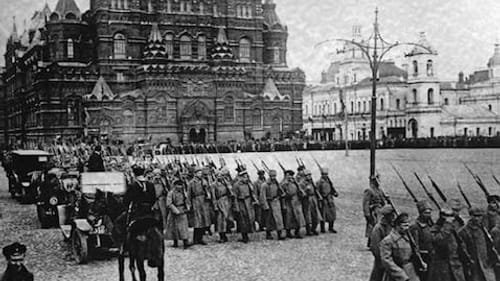Stay in the Loop
BSR publishes on a weekly schedule, with an email newsletter every Wednesday and Thursday morning. There’s no paywall, and subscribing is always free.
As radical as reality itself
'October: The Story of the Russian Revolution' by China Miéville

“One must try to be as radical as reality itself,” Vladimir Lenin told a friend 100 years ago. The men and women of Petrograd were rising in the revolutionary heat of 1917, and keeping up with the twists and turns of events confounded even the legendary Bolshevik leader. In his new book October: The Story of the Russian Revolution, China Miéville—a London author and activist better known for his mind-bending speculative fiction and for Salvage, the political-literary journal he recently cofounded—offers a dramatic retelling of that world-changing year in Russia.
At the Free Library of Philadelphia (FLP) on May 16, Miéville took the stage along with the FLP’s Joel Nichols to discuss the book and its implications for the upheavals of 2017. Miéville’s soft-spoken warmth and generosity belie his rakish-pirate look, and his talk was full of humor and a nerdy glee for the juicy details of his topic.
Ground zero for arguments about social change
And what a topic it is. At its centenary, the Russian Revolution remains a hot-button issue, liable to provoke arguments among politically minded people of all stripes. “October is still ground zero for arguments about fundamental, radical social change,” Miéville writes. “Its degradation was not a given, was not written in any stars.” During most of 1917, between the year’s two revolutions, Russia was governed by a “dual power”—a provisional government and the workers’ council, called the Soviet, uneasily coexisting as Russia continued to participate in the carnage of World War I.
That tension runs through the book and ties biographical details into the grand sweep of history, emphasizing the intrigue and drama of this year, its incredible chances and coincidences. “If I were to write some of these scenes in a novel,” Miéville said, “my editor would tell me it was too heavy-handed.” Fans of his lush language and virtuoso vocabulary will find them here; we even get some choice wordplay (of Tsar Nicholas he writes, “nothing seems to stir behind those placid tsarry eyes”). There’s even a faint whiff of steampunk about this “revolution of trains,” as he calls it, “history proceeding in screams of cold metal.”
Storytelling and history
The Russian Revolution is many things to many people; to Miéville, it’s a damn good story, and his relish for telling it is evident throughout, though every detail comes from the historical record.

This book is accessible to those who know little about the revolution; what’s amazing about it, though, is how many treasures it holds for those who do know this history. We hear not only Lenin, Leon Trotsky, and Alexandra Kollontai but also colorful and less-known figures like the fiery Maria Spiridinova, who was imprisoned and tortured for shooting a Tsarist officer, served 10 years in a Siberian prison, and when freed after the revolution was immediately elected mayor of the prison’s town. (Her first act was to order the prisons blown up.)
Hope without happy endings
However, there is, as Miéville was careful to point out onstage, “no hagiography here,” no “cosplay politics.” The Bolsheviks get a sympathetic but fair portrayal, and their enemies get a hearing, too (Churchill refers to their politics as “foul baboonery”). Of Stalin (who would later have Trotsky murdered), Miéville writes:
Stalin, of course, was not yet Stalin. Today, any account of the revolution is haunted by a ghost from the future, that twinkly-eyed, moustachioed monstrosity, Uncle Joe, the butcher, key architect of a grotesque and crushing despotic state – the -ism that bears his name.
The epilogue grapples with the enormous task of summing up the aftermath of 1917. Miéville traces the factors—war, starvation, other failed revolutions, geopolitical power struggles—that take the revolution from workers’ power to an order that “is anything but socialist. Instead, the months and years that follow will see the revolution embattled, assailed, isolated, ossified, broken. We know where this is going: purges, gulags, starvation, mass murder.”
How, then, should we look at 1917 today, as we question what it really means to stand up against a despotic ruler? “It would be absurd, a ridiculous myopia, to hold up October as a simple lens through which to view the struggles of today,” Miéville tells us. “But it has been a long century, a long dusk of spite and cruelty, the excrescence and essence of its time. Twilight, even remembered twilight, is better than no light at all.”
For Pamela Forsythe's review of the National Museum of American Jewish History's 1917: How One Year Changed the World, click here.
What, When, Where
October: The Story of the Russian Revolution. By China Miéville. London: Verso, 2017. 369 pages. Hardcover. $26.95. Click here.
Sign up for our newsletter
All of the week's new articles, all in one place. Sign up for the free weekly BSR newsletters, and don't miss a conversation.

 Sarah Grey
Sarah Grey